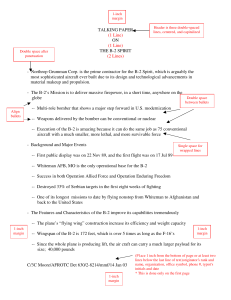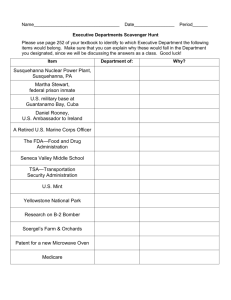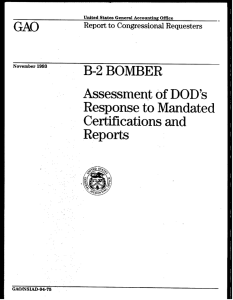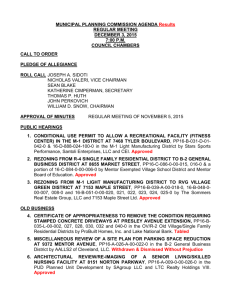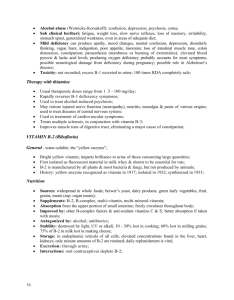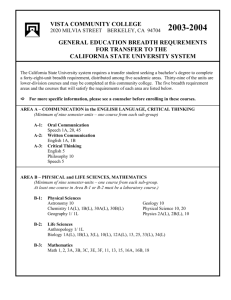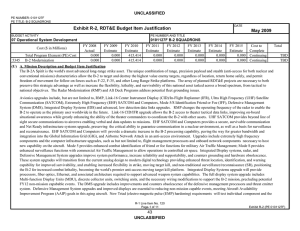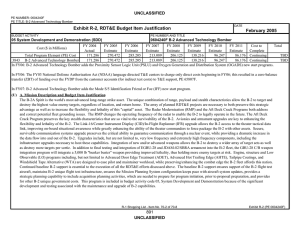T B-2 AIR FORCE PROGRAMS
advertisement
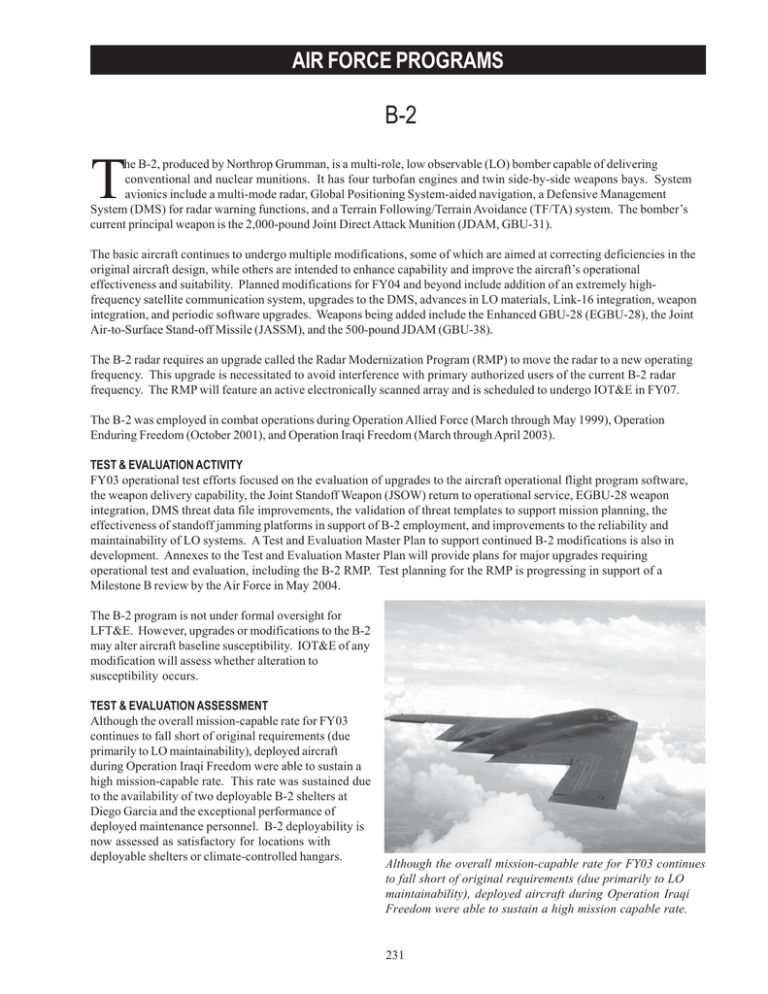
AIR FORCE PROGRAMS B-2 T he B-2, produced by Northrop Grumman, is a multi-role, low observable (LO) bomber capable of delivering conventional and nuclear munitions. It has four turbofan engines and twin side-by-side weapons bays. System avionics include a multi-mode radar, Global Positioning System-aided navigation, a Defensive Management System (DMS) for radar warning functions, and a Terrain Following/Terrain Avoidance (TF/TA) system. The bomber’s current principal weapon is the 2,000-pound Joint Direct Attack Munition (JDAM, GBU-31). The basic aircraft continues to undergo multiple modifications, some of which are aimed at correcting deficiencies in the original aircraft design, while others are intended to enhance capability and improve the aircraft’s operational effectiveness and suitability. Planned modifications for FY04 and beyond include addition of an extremely highfrequency satellite communication system, upgrades to the DMS, advances in LO materials, Link-16 integration, weapon integration, and periodic software upgrades. Weapons being added include the Enhanced GBU-28 (EGBU-28), the Joint Air-to-Surface Stand-off Missile (JASSM), and the 500-pound JDAM (GBU-38). The B-2 radar requires an upgrade called the Radar Modernization Program (RMP) to move the radar to a new operating frequency. This upgrade is necessitated to avoid interference with primary authorized users of the current B-2 radar frequency. The RMP will feature an active electronically scanned array and is scheduled to undergo IOT&E in FY07. The B-2 was employed in combat operations during Operation Allied Force (March through May 1999), Operation Enduring Freedom (October 2001), and Operation Iraqi Freedom (March through April 2003). TEST & EVALUATION ACTIVITY FY03 operational test efforts focused on the evaluation of upgrades to the aircraft operational flight program software, the weapon delivery capability, the Joint Standoff Weapon (JSOW) return to operational service, EGBU-28 weapon integration, DMS threat data file improvements, the validation of threat templates to support mission planning, the effectiveness of standoff jamming platforms in support of B-2 employment, and improvements to the reliability and maintainability of LO systems. A Test and Evaluation Master Plan to support continued B-2 modifications is also in development. Annexes to the Test and Evaluation Master Plan will provide plans for major upgrades requiring operational test and evaluation, including the B-2 RMP. Test planning for the RMP is progressing in support of a Milestone B review by the Air Force in May 2004. The B-2 program is not under formal oversight for LFT&E. However, upgrades or modifications to the B-2 may alter aircraft baseline susceptibility. IOT&E of any modification will assess whether alteration to susceptibility occurs. TEST & EVALUATION ASSESSMENT Although the overall mission-capable rate for FY03 continues to fall short of original requirements (due primarily to LO maintainability), deployed aircraft during Operation Iraqi Freedom were able to sustain a high mission-capable rate. This rate was sustained due to the availability of two deployable B-2 shelters at Diego Garcia and the exceptional performance of deployed maintenance personnel. B-2 deployability is now assessed as satisfactory for locations with deployable shelters or climate-controlled hangars. Although the overall mission-capable rate for FY03 continues to fall short of original requirements (due primarily to LO maintainability), deployed aircraft during Operation Iraqi Freedom were able to sustain a high mission capable rate. 231 AIR FORCE PROGRAMS The most promising near-term improvement to LO maintainability (alternate high-frequency materials (AHFM), in conjunction with the implementation of a primer/sealer) has not undergone OT&E or reached the operational squadrons. The Air Force plans to verify through OT&E of AHFM-modified B-2 aircraft that no degradation to B-2 baseline LO characteristics occurs and that AHFM can support the Air Force sortie generation requirement. However, the B-2 community does not currently possess an organic capability to accurately identify LO defects and verify the LO quality of repairs. This is primarily due to the lack of integrated diagnostic tools. Sole reliance on the LO Combat Readiness Model to evaluate aircraft LO capability is also not effective, given limitations in modeling and inspection routines. Operational tests during FY03 demonstrate the LO Combat Readiness Model is incorrect 83 percent of the time in predicting B-2 signature suitability for combat operations. The DMS does not provide adequate situational awareness to avoid pop-up threats. DMS mission data file improvements continue to be made, but additional upgrades that may resolve DMS capability shortfalls are not funded. Operational testing of the Situational Awareness Communications upgrade, which is an enhancement to mission flexibility, demonstrated the ability to enable the warfighter to plan and transmit missions to aircraft en route. This capability was used in Operation Iraqi Freedom. Five JDAMs were released during an Air Force Quick Reaction Test in December 2002 and 583 JDAMs were delivered during Operation Iraqi Freedom. Results identified in the Quick Reaction Test met requirements. The addition of the smart bomb rack assembly with the next operational flight program software upgrade in 2004 should provide the capability to deliver up to 80 500-pound JDAM weapons. The Air Force carried out separation and guided weapon releases of up to 80 500-pound JDAM in FY03. Developmental testing indicates the potential for the 500-pound variant to meet requirements when delivered from the B-2. The Air Force plans operational testing of the B-2 with this JDAM variant in FY04. The Air Force conducted operational testing of the JSOW (Baseline) weapon on the B-2 in March and April 2003, including captive carry releases and live launches of three JSOW (Baseline) weapons, to restore the JSOW to B-2 operational use. Although only one weapon dispensed bomblets within Operation Requirements Document criterion, the Air Force elected interim operational fielding of the JSOW (Baseline) on the B-2 provided workarounds are employed. These workarounds do not affect the ability of the B-2 to employ the JSOW effectively. However, additional tests of JSOW on the B-2 are required to increase confidence in JSOW/B-2 effectiveness. Developmental testing of the EGBU-28 on the B-2 indicates the weapon has the potential to meet user requirements. However, the Air Force identified potential upgrades as a result of operational testing for possible future implementation. Integration testing of the EGBU-28 should conclude in FY04. 232
